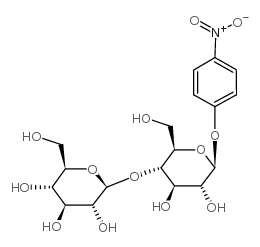4-Nitrophenyl β-D-Cellobioside

4-Nitrophenyl β-D-Cellobioside structure
|
Common Name | 4-Nitrophenyl β-D-Cellobioside | ||
|---|---|---|---|---|
| CAS Number | 3482-57-3 | Molecular Weight | 463.39000 | |
| Density | 1.7 g/cm3 | Boiling Point | 795.6ºC at 760 mmHg | |
| Molecular Formula | C18H25NO13 | Melting Point | 249-250ºC | |
| MSDS | Chinese USA | Flash Point | 435ºC | |
|
Mechanistic studies of active site mutants of Thermomonospora fusca endocellulase E2.
Biochemistry 38(30) , 9746-51, (1999) Endocellulase E2 from the thermophilic bacterium Thermomonospora fusca is a member of glycosyl-hydrolase family 6 and is active from pH 4 to 10. Enzymes in this family hydrolyze beta-1,4-glycosidic bonds with inversion of the stereochemistry at the anomeric c... |
|
|
Structural changes of cellobiohydrolase I (1,4-beta-D-glucan-cellobiohydrolase I, CBHI) and PNPC (p-nitrophenyl-beta-D-cellobioside) during the binding process.
Sci. China,. C, Life Sci. 51(5) , 459-69, (2008) Conformational changes to 1,4-beta-D-glucan cellobiohydrolase I (CBHI) in response to its binding with p-nitrophenyl beta-D-cellobioside (PNPC) were analyzed by second-derivative fluorescence spectrometry at the saturation binding point. Irreversible changes ... |
|
|
The competitive inhibition of Trichoderma reesei C30 cellobiohydrolase I by guanidine hydrochloride.
FEBS Lett. 270(1-2) , 143-6, (1990) The p-nitrophenylcellobiosidase (PNPCase) activity of Trichoderma reesei cellobiohydrolase I (CBH I) was competitively inhibited by concentrations of guanidine hydrochloride (Gdn HCl) that did not affect the tryptophan fluorescence of this enzyme. The Km of C... |
|
|
A monovalent anion affected multi-functional cellulase EGX from the mollusca, Ampullaria crossean.
Protein Expr. Purif. 31(1) , 108-114, (2003) A cellulose hydrolytic enzyme was isolated from the stomach juice of Ampullaria crossean, a kind of herbivorous mollusca. The enzyme was purified 45.3-fold to homogenety by ammonium sulfate precipitation, DEAE-Sephadex A-50 column, Bio-gel P-100 gel filtratio... |
|
|
The kinetics ofp-nitrophenyl-β-d-cellobioside hydrolysis and transglycosylation byThermobifida fuscaCel5Acd
Carbohydr. Res. 345(17) , 2507-15, (2010) The hydrolysis of p-nitrophenyl-β-1,4-cellobioside (pNP-G2) by the catalytic domain of the retaining-family 5-2 endocellulase Cel5A from Thermobifida fusca (Cel5Acd) was studied. The dominant reaction pathway involves hydrolysis of the aglyconic bond, produci... |
|
|
Process of thermal denaturation of xylanase (XynB) from Clostridium stercorarium F-9.
Biosci. Biotechnol. Biochem. 59(1) , 47-50, (1995) The thermal denaturation process of Clostridium stercorarium F-9 xylanase (XynB) was studied by monitoring remaining activity and recovered activity of the enzyme. At pH 5.5, aggregation occurred rapidly after the thermal denaturation initiated. The aggregate... |
|
|
Characterization of cellobiohydrolase from a newly isolated strain of Agaricus arvencis.
J. Microbiol. Biotechnol. 21(7) , 711-8, (2011) A highly efficient cellobiohydrolase (CBH)-secreting basidiomycetous fungus, Agaricus arvensis KMJ623, was isolated and identified based on its morphological features and sequence analysis of internal transcribed spacer rDNA. An extracellular CBH was purified... |
|
|
Purification and characterization of a thermostable cellobiohydrolase from Fomitopsis pinicola.
J. Microbiol. Biotechnol. 20(12) , 1681-8, (2010) A screening for cellobiohydrolase (CBH) activity was performed and Fomitopsis pinicola KMJ812 was selected for further characterization as it produced a high level of CBH activity. An extracellular CBH was purified to homogeneity by sequential chromatography ... |
|
|
In vitro cellulolytic activity of the plant pathogen Clavibacter michiganensis subsp. sepedonicus.
Can. J. Microbiol. 41(10) , 877-88, (1995) The activity of four Clavibacter michiganensis subsp. sepedonicus strains against various cellulose substrates was investigated. Sixty-seven Clavibacter michiganensis subsp. sepedonicus strains grew well on media amended with carboxymethylcellulose, 64 strain... |
|
|
Kinetic characterization of glycosidase activity from disaccharide conjugate to monosaccharide conjugate in Caco-2 cells.
J. Pharm. Pharmacol. 57(5) , 661-4, (2005) Glycosidase activity influences the intestinal absorption of glycosides. Our previous study in rats suggested that disaccharide conjugates might be prototypes for pre-prodrugs aiming at the Na(+)/glucose co-transporter-mediated transport of prodrugs (drug glu... |